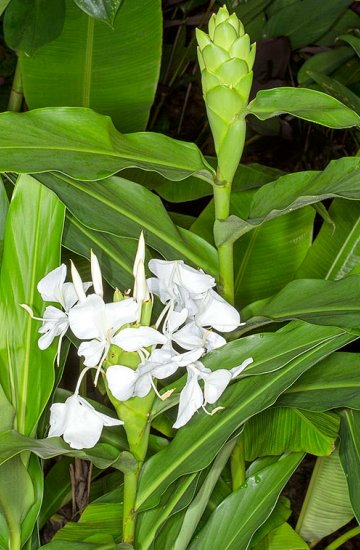
|
|
White Ginger Lily
(Hedychium coronarium).
|
White Ginger Lily - Hedychium coronarium
Hedychium coronarium (white garland-lily or white ginger lily is a perennial flowering plant in the Zingiberaceae (ginger) family, native to the Eastern Himalayas region of India (Sikkim and Tripura), Bangladesh, Nepal and Bhutan, through northernmost Myanmar and Thailand, southern China (Yunnan, Sichuan, Hunan, Guangxi and Guangdong) to Taiwan in the East. It is typically found growing in the forest understory, where the pseudostems arising from rhizomes below ground may reach 1-3m in height. In its native environment flowering occurs between August and December.
Genus name comes from the Greek words hedys meaning sweet and chion meaning snow.
It is a rhizomatous tender perennial that may grow to 3m tall in its native habitat, in humid forests up to 1800m
but more typically grows
1-2m tall. Features large, lance-shaped, medium green leaves (to 60cm long x
12cm wide). Strongly fragrant white flowers in dense elliptical racemes
(10-20cm long) in late summer to early fall, reminiscent of butterflies in shape and Gardenias in scent.
Hence the sometimes used common name of butterfly ginger for this species.
While the leafy shoots are not cold hardy, the thick underground rhizome will easily survive some cold and drought. In the tropics it will grow and flower year-round.
It is commonly cultivated in warm temperate and subtropical regions of the world as an ornamental. In China it is cultivated for use in medicine and production of aromatic oil, due to the strong characteristic fragrance of the flowers, said to be reminiscent of jasmine. It is a perennial-green, growing in warmer climates, but may also be grown in mild winter temperate regions of North America and Europe, where it dies back in winter but re-emerges in spring.
H. coronarium is the national flower of Cuba, where it is known as mariposa (literally "butterfly") due to its shape. Women used to adorn themselves with these fragrant flowers in Spanish colonial times; because of the intricate structure of the inflorescence, women hid and carried secret messages important to the independence cause under it. The plant has become naturalized in the cool rainy mountains in Sierra del Rosario, Pinar del Rio Province in the west, the Escambray Mountains in the center of the island, and in the Sierra Maestra in the very east of it.
Young buds and flowers are eaten or used as a flavouring. Root - cooked. A famine food used when all else fails.
The seed is aromatic, carminative and stomachic. The root is antirheumatic, excitant and tonic. The ground rhizome is used as a febrifuge. An essential oil from the roots is carminative and has anthelmintic indications. The plant has been used as a remedy for foetid nostril.
The stems contain 43 - 48% cellulose and are useful in making paper. An essential oil obtained from the flowers is valued in high grade perfumes. The root contains 1.7% essential oil, which is used medicinally.
Beyond its native range H. coronarium may be invasive in shallow water systems, along streams and in waterlogged areas. Once established, it is difficult to control due to vegetative reproduction through the underground spread of rhizomes. It was introduced in Brazil in the era of slavery, said to have been brought to the country by African slaves who used its leaves as mattresses, and is now considered naturalised in the states of Rio de Janeiro (where it is classed as invasive), Bahia and Espirito Santo. This species was first introduced as an ornamental to Hawaii around 1888 by Chinese immigrants, and is now considered a serious invader in mesic to wet areas of Maui and Hawaii island. Additionally, it is invasive in South Africa, where it is a declared weed, and propagation of plant material is considered prohibited. It is also invasive in New Caledonia.
It is ironic that whilst awareness of invasive Hedychium spp. including H. coronarium, is on the rise worldwide, the humid submontane forest ecosystems from which they originate are fast becoming the most threatened ecosystems in the world and a number of wild gingers are listed as endangered by the Botanical Survey of India.
Source:
https://en.wikipedia.org/wiki/Hedychium_coronarium
http://www.missouribotanicalgarden.org/
PlantFinder/PlantFinderDetails.aspx?taxonid=287579
https://pfaf.org/user/Plant.aspx?LatinName=Hedychium+coronarium
https://www.cabi.org/isc/datasheet/26678
